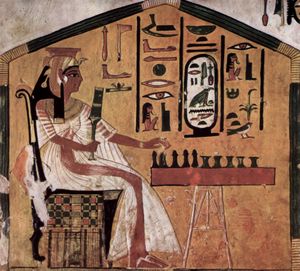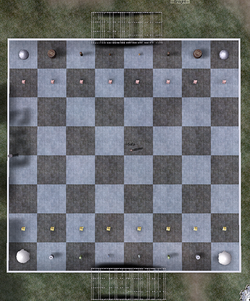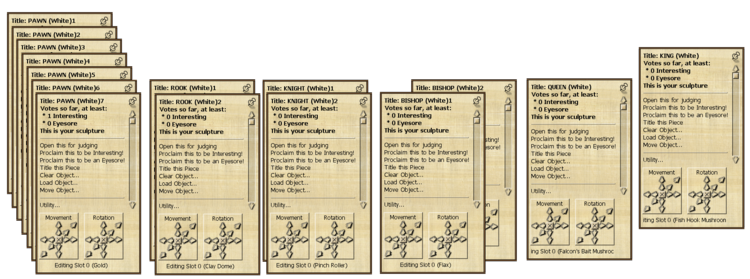The Wiki for Tale 6 is in read-only mode and is available for archival and reference purposes only. Please visit the current Tale 11 Wiki in the meantime.
If you have any issues with this Wiki, please post in #wiki-editing on Discord or contact Brad in-game.
Chess
About Chess
Chess is a two-player strategy board game played on a chessboard, a checkered gameboard with 64 squares arranged in an eight-by-eight grid. It is one of the world's most popular games, played by millions of people worldwide in homes, parks, clubs, online, by correspondence, and in tournaments. In recent years, chess has become part of some school curricula.
Each player begins the game with 16 pieces: one king, one queen, two rooks, two knights, two bishops, and eight pawns. Each of the six piece types moves differently. The objective is to 'checkmate' the opponent's king by placing it under an inescapable threat of capture. To this end, a player's pieces are used to attack and capture the opponent's pieces, while supporting their own. In addition to checkmate, the game can be won by voluntary resignation by the opponent, which typically occurs when too much material is lost, or if checkmate appears unavoidable. A game may also result in a draw in several ways, where neither player wins. The course of the game is divided into three phases: opening, middlegame, and endgame.
Movement White always moves first. After the first move, players alternately move one piece per turn (except for castling, when two pieces are moved). Pieces are moved to either an unoccupied square or one occupied by an opponent's piece, which is captured and removed from play.
Each chess piece has its own style of moving. In the diagrams, the dots mark the squares where the piece can move if no other pieces (including one's own piece) are on the squares between the piece's initial position and its destination.
The king moves one square in any direction. The king has also a special move which is called castling and involves also moving a rook.
The rook can move any number of squares along any rank or file, but may not leap over other pieces. Along with the king, the rook is involved during the king's castling move.
The bishop can move any number of squares diagonally, but may not leap over other pieces.
The queen combines the power of the rook and bishop and can move any number of squares along rank, file, or diagonal, but it may not leap over other pieces.
The knight moves to any of the closest squares that are not on the same rank, file, or diagonal, thus the move forms an "L"-shape: two squares vertically and one square horizontally, or two squares horizontally and one square vertically. The knight is the only piece that can leap over other pieces.
The pawn may move forward to the unoccupied square immediately in front of it on the same file, or on its first move it may advance two squares along the same file provided both squares are unoccupied (black "●"s in the diagram); or the pawn may capture an opponent's piece on a square diagonally in front of it on an adjacent file, by moving to that square (black "x"s). The pawn has two special moves: the en passant capture and pawn promotion.
Compound Chess
Compound chess is a playable ATITD version of the original game. Requires 64 cell (8x8) compound -hence the compound name- as the chess board and 32 sculptures for individual chess pieces. Each sculpture holds one item (piece) in order to move pieces easier. Pieces are usually moved around with macro aid but they can be moved manually as well.
Before playing 16 different items should be chosen and loaded to sculptures to represent pawns, rooks, knights, bishops, queen and king.
If a feature to move every sculpture item at once gets added, actual chess piece models can be used. --Safa 17:23, 29 March 2015 (EST)
A public compound chess board can be found at 1560, 2815 River Plains. You can also join CHESS guild next to this board to talk to other chess enthusiasts and look for worthy opponents.
How to Play
After who plays white and who plays black is decided, both players stack their sculpture windows. These windows can be pushed out of the screen to make room for the board. After this point normal chess rules apply but since White and Black sculptures are far from each other players can't interact with pieces they don't own. This means when a piece is to be eliminated, owner should move his piece for other player. This can be done by lowering the piece underground until it isn't visible anymore.
It is common courtesy to move everything back to its original place after a game is done.
Compound Chess Pieces
| Pawn | Rook | Knight | Bishop | Queen | King |
 |
 |
 |
 |
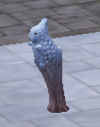 |
 |
| Pawn | Rook | Knight | Bishop | Queen | King |
 |
 |
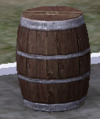 |
 |
 |
 |
Map
